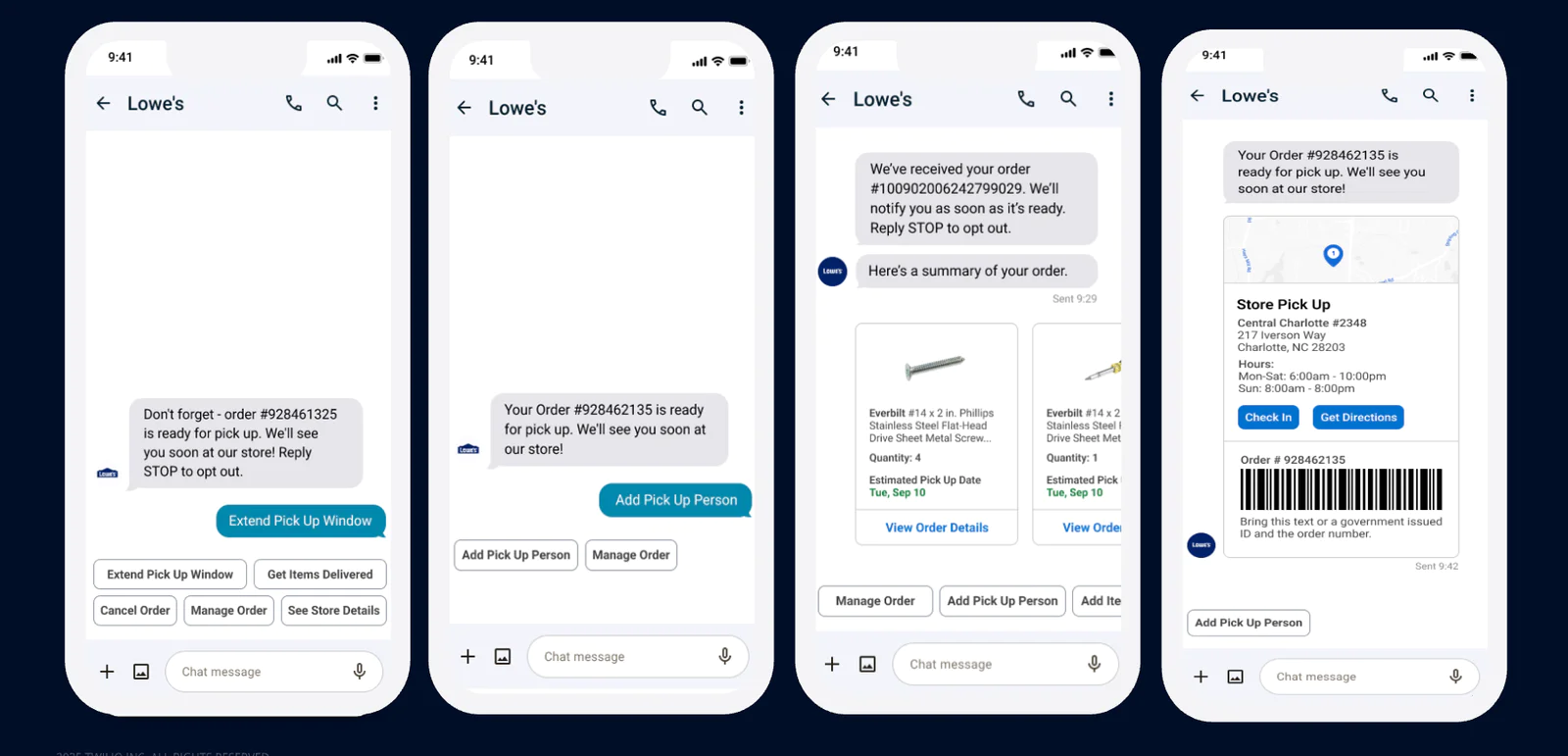Modern messaging with RCS: Your webinar recap
Time to read:
Modern messaging with RCS: Your webinar recap
Rich Communication Services (RCS) offers brands new opportunities to engage with your customer base. In the webinar, Powering Modern Messaging with RCS, Twilio product experts, partners, and customers discuss this new era of messaging and how you can transform your customer engagement by leveraging RCS.
Watch the webinar or keep reading for the main takeaways.
Why RCS matters now: messaging as prime real estate
While companies historically vied for the home screen of your smart device, the prioritization is changing. Your phone’s message app (whether iMessages for Apple users or Google messages for Android) is one of the most frequently used—checked first thing in the morning and last before bed. Now, with RCS, those messages can have branding and engagement that blurs the line between a messaging experience and an app.
According to Steve Broff, Google’s Global GTM Head, RCS for Business, that prime placement is shifting, “We think that a new paradigm is coming forward where the most valued real estate of the smartphone is no longer the homepage, but the inbox.”
With 89% of consumers wanting to connect with businesses over messaging and 77% of consumers more likely to purchase when they can message businesses, now is the time to take advantage of the latest messaging advancements.
A quick overview: messaging advancements with RCS
Before we dig into the opportunity RCS provides, let’s quickly review RCS capabilities. RCS represents the biggest advancement in messaging since SMS, enabling companies to send verified, branded messages with interactive features.
With RCS, businesses can add their logo and name to the message so that their business is immediately recognized as a trusted source. It also provides:
Verified sender identification
HTTPS-enabled secure messaging
Protection against spoofing and fraud
While SMS messages are constrained to 160 characters, RCS messages can not only be longer, they can also feature components like:
Images, videos, GIFs
One-tap replies
QR codes
Time savings actions
Google Wallet integration
The personalization opportunity
While the RCS capabilities themselves are impressive, the benefit of RCS goes far beyond the features, enabling companies to enhance personalization, strengthen engagement rates, and drive additional revenue. Instead of a quick, all-text message from an unidentifiable short code, RCS allows businesses to craft unique, personalized messaging experiences for their customers.
McKinsey & Company reveals that companies excelling at personalization generate 40% more revenue than their competitors. However, there's a significant gap between business perception and customer reality: While 82% of companies believe they excel at personalization, only 16% of consumers agree.
RCS bridges this gap by helping companies create truly personalized messaging experiences on the channel customers already prefer.
The growing RCS landscape
While it’s great to know the advantages of RCS, it’s only helpful if you can use it. Fortunately, RCS is rapidly expanding worldwide.
Global adoption and US market momentum
RCS has strong adoption rates across key markets. The average capability and reach for RCS in priority countries is as follows:
Germany: 77%
France: 75%
Spain: 74%
Brazil: 60%
UK: 60%
Mexico: 51%
United States: 47%
While the US is currently on the lower end of availability, it will dramatically increase later this year. Two of the three major US carriers have already enabled RCS, and with AT&T adopting RCS this year, availability will grow nationwide.
The US market has also developed an innovative pricing model for RCS that includes rich features like branding, suggested replies, and website links at the entry-level price point, making RCS accessible for businesses of all sizes.
Real-world example: how Lowe’s transforms customer engagement
While the benefits of RCS are extensive, sometimes you need to see it to believe it. Learn how this home improvement giant used RCS to streamline communications and elevate their customers’ experiences.
The challenge: During COVID-19, Lowe’s doubled digital order volumes as customers turned to pickup and delivery options instead of in-store shopping. Lowe’s needed to streamline their pickup and delivery processes while providing clear customer communication.
The solution: Lowe’s built pathways of communications through email, SMS, and RCS to create greater efficiency throughout the ordering process. Toni Campbell, Senior Product Manager at Lowe’s, shared that they were first drawn to RCS because of the ability to brand and verify RCS messages.
“When a customer sees that text from Lowe's, they're really able to trust that that text came from Lowe's and is not an impersonator,” shares Campbell.
Using a crawl, walk, run methodology, Lowe’s started with branded RCS messages before creating a roadmap for other functionality, such as building out a pick-up and delivery flow. The example below features Lowe’s pick-up in-store flow, reminding customers of their pickup, suggesting ways to manage their order, and updating customers every step of the way.


The result: Prior to RCS, about 5% of all truck deliveries had to go back out due to challenges with delivery, such as the recipient canceling their delivery at the last minute or being away from home at the time of delivery. Since adopting RCS, Lowe’s has seen a 20% reduction in those trip redelivery rates, resulting in significant savings to Lowe’s bottom line.
“That's money that we don't lose by having to go back out twice, having to reload that truck twice with the same item...Not only are we sending that customer the notification, ‘Hey, we're going to be at your house tomorrow,’ that customer can engage back with us and say, ‘Hey, I’m not going to be home,’” said Campbell.
How does RCS work at Twilio?
RCS has been built into Twilio’s platform to make it easy for businesses to set up and get started. Twilio’s RCS Business Messaging includes:
Integration with Twilio Messaging: Twilio has directly integrated RCS into its Programmable Messaging API so no code changes are needed to implement RCS into your current messaging solution.
Automatic detection and fallback options: Twilio will automatically detect the RCS capable devices and upgrade your message to a branded sender message if available. If RCS is unavailable, Twilio will make sure your message is delivered by falling back to SMS.
RCS messaging data: Get insights into your RCS sending. Analyze your RCS read receipts, delivery receipts, and click data alongside your other messaging channels in the messaging insights portal, webhooks, CSVs, or event streams.
Twilio Content Template Builder: Build and manage rich content via the no-code console or API. You can design templates for both RCS and SMS. Plus, access live previews of the messages before you test them.
Enhanced Customer Data Platform integration: For businesses looking to maximize RCS impact, Twilio Segment provides the data foundation to create truly personalized messaging. By breaking down data silos and creating unified customer profiles, businesses can deliver contextually relevant RCS messages that support every stage of your customer’s journey.
For specifics on how to set up RCS, check out our article, Get Started with RCS and Twilio.
Develop your RCS strategy: next steps
As RCS moves into general availability, now is the time to explore how rich messaging can transform your customer engagement strategy. Whether you're a small business looking to build trust with branded messages or an enterprise seeking to reduce operational costs through interactive communications, RCS offers scalable solutions for every use case.
Twilio will be launching RCS into GA later this month. Start exploring today the experiences you can build with RCS.
Frequently asked questions about RCS
Is RCS suitable only for enterprise organizations?
No, RCS can support small and medium businesses, helping them engage their customer base with personalized communication flows.
Is RCS available in the US?
Yes! RCS is growing in availability within the US. Two out of three major carriers have adopted RCS and the third carrier is adopting RCS later this year.
What happens if recipients do not have RCS?
When setting up RCS, you can select SMS as the fallback option. That way, if someone does not have RCS enabled or available with their carrier, they will still receive the message in the SMS format.
How quickly can I get started?
With Twilio's integrated platform, you can begin exploring RCS capabilities immediately with no code changes required to your existing Twilio messaging solution.
Related Posts
Related Resources
Twilio Docs
From APIs to SDKs to sample apps
API reference documentation, SDKs, helper libraries, quickstarts, and tutorials for your language and platform.
Resource Center
The latest ebooks, industry reports, and webinars
Learn from customer engagement experts to improve your own communication.
Ahoy
Twilio's developer community hub
Best practices, code samples, and inspiration to build communications and digital engagement experiences.


